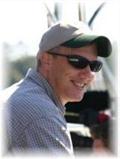By Brad Rich and Frank Tursi
First of a two parts
 |
MOREHEAD CITY – Most people in North Carolina have never seen an Atlantic sturgeon. Once common along our coast, the fish became so rare that to preserve the remaining population the state more than 20 years ago made it illegal to possess a sturgeon. Starting Friday, though, the full weight of the U.S. government will get behind the protection of what remains of this ancient fish whose ancestors swam among dinosaurs.
Supporter Spotlight
Once prized for its roe to make caviar, the Atlantic sturgeon will officially go on the federal Endangered Species List that day, not only in North Carolina, but also in the Delaware and Hudson rivers, the Chesapeake Bay and the rest of the South Atlantic Ocean. The decision comes after three years of study and a petition from an environmental group urging that it be declared endangered.
The listing carries with it severe penalties for trafficking or for intentionally killing or maiming a sturgeon, or in the language of the Endangered Species Act, “taking.” Lesser offenses carry lesser fines. The law also requires that the federal government devise a plan to protect the fish’s habitat in order to bring its population back to an acceptable level. That will come later and could include restrictions on such things as commercial fishing gear and how and when inlets are dredged.
Depending on where you stand, the listing is good news for an old fish in trouble or an economic burden that will cost the states too much to comply with, place restrictions on an already beleaguered commercial fishing industry and make it harder to dredge inlets and pump sand on beaches for fear of unintentionally sucking up a sturgeon.
North Carolina officials took the latter stand. Like officials in other affected states, they opposed the listing. Officials at the state Division of Marine Fisheries – the administrative agency of the rule-making Marine Fisheries Commission – aren’t too worried about fishermen being fined for intentionally taking sturgeon, since the fish has been off limits since 1991. They’re much more concerned about those secondary effects, particularly the changes that might be required for fishing gear that could unintentionally snag a sturgeon as “bycatch.”
“We don’t know exactly what’s going to happen, and we won’t know for some time,” said Jacob Doyd, a protected species biologist at the fisheries division’s main office in Morehead City. “We don’t know what they (the feds) are going to put in place to protect the habitat of the fish.
Supporter Spotlight
“The fishery has been closed for more than two decades here, and we agree with the Atlantic States Marine Fisheries Commission that the species is not in decline,” he said. “Our surveys have not showed a decline.”
The commission is made up of 15 states along the East Coast that attempts to coordinate the management and conservation of fish that share the states’ waters. North Carolina is a member of the commission.
Rather than listing the fish as endangered, the division would have preferred continuing the effort to get more and better information about the sturgeon by using more observers on fishing vessels in waters that the sturgeon is likely to be found.
 Tim Gestwicki Tim Gestwicki |
Count Tim Gestwicki, though, with those who think that federal protection of the fish is long overdue. He’s the executive director of the N.C. Wildlife Federation, which wrote a letter in December to the National Marine Fisheries Service in support of the listing. The service is one of two federal agencies that administer the Endangered Species Act. Gestwicki noted in the letter that the sturgeon population in North Carolina is at a historic low, and the 20-year-old state ban has done nothing to appreciably improve it.
“We believe the time has come to list the Atlantic sturgeon as an endangered species and to invoke the most stringent protective measures possible to save this species from extinction,” he wrote. “Closure of traditional fishing activities has done nothing to stimulate recovery of the fishery. The extra level of protection of the Endangered Species Act may relieve mortality from other sources and help the Atlantic sturgeon survive.”
Be Wary of Sturgeon
Atlantic sturgeon (Acipenser oxyrinchus) were so abundant along the East Coast in the mid-1800s that boaters along the Susquehanna River in Pennsylvania were warned about them. A fish that could reach 15 feet in length and weigh up to 800 pounds would do severe damage to wooden boats if the unwary pilot happened to come upon one accidentally. Back then, these giants, which spend most of their lives in saltwater, ranged all along the Atlantic Seaboard, from Labrador down to Florida, undertaking extensive migrations of up to 900 miles.
Each winter and spring, they moved up rivers to spawn. There, the females dropped their adhesive eggs that attached to rocks, gravel or woody debris and hatched within a week. Those spawning runs could extend far upstream. Sturgeon bones have been found in the 800-year-old trash pits of Native Americans living along the Yadkin River in North Carolina, 300 miles from the ocean.
It is an ancient fish, experts believe, a survivor of the Ice Age and beyond. They are considered to be the most primitive of bony fish, with origins dating back 120 million years.

Atlantic sturgeon on a Maryland dock in 1901. |
But they almost didn’t make through the 20th century. Prized for their fleshy white meat and abundance of roe, the sturgeon supported a thriving fishery. One researcher likened the harvest of sturgeon at the turn of the century to clear-cutting a forest. In the late 1800s, four to five railroad cars a day brought sturgeon caviar into New York City. In less than a decade, the fishery collapsed at a place called Caviar Point, N.J. Other places soon followed.
The Industrial Revolution added to the damage by destroying the sturgeon’s spawning habitat on many rivers or by blocking its spawning runs with dams.
Numbers improved a little after the federal Clean Water Act of 1973. Sturgeon can live for 50 years or more, but they are late bloomers when it comes to reproduction, which makes population recovery slow. And there are still problems on many rivers, where poorly oxygenated water and siltation because of dredging, agricultural runoff and other factors have impeded the survival of eggs. What’s more, the shrinking of freshwater habitat is causing problems for juveniles, which spend up to six years in their natal rivers and are intolerant of saltwater. Rising sea levels because of climate change may also have increased rivers’ salinity.
Jack Spruill of Hamstead grew up on Albemarle Sound, where the Atlantic and the related shortnose sturgeon have lived thousands of years and were part of the commercial fishing heritage of his family.
“Sadly, perhaps partly due to no restrictions on their catches, there was a collapse of the populations of both sturgeon species in North Carolina in the late 1940s or early 1950s,” he recently told the Marine Fisheries Commission in support of the Atlantic sturgeon’s listing. The shortnose sturgeon is already listed as endangered.
The story is the same around the world for the various species of sturgeon. The Washington-based Consortium for Ocean Leadership reported in 2010 that 85 percent of sturgeon populations worldwide were at risk of becoming extinct.
In some U.S. states, Atlantic sturgeon populations have plummeted to 99 percent of their historic levels. The National Marine Fisheries Service said in its ESA listing proposal that the populations in the Carolinas are probably at less than 3 percent of those levels.
“None of the populations are large or stable enough … to provide any level of certainty for continued existence,” the proposal concluded.
Wednesday: Consternation and joy







